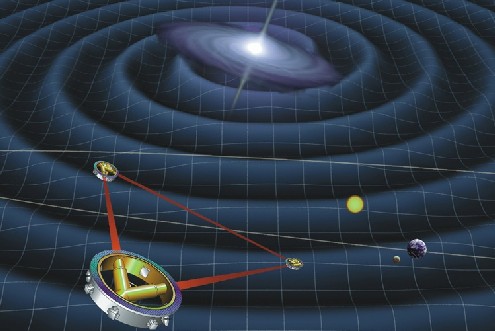
Gravitational waves could be detected using interferometry Credit: NASA
By James Dacey
Big physics projects like the LHC that tackle some of the most fundamental questions in science are clearly a double-edged sword for journalists. On the one hand, it is relatively easy — and can be very enjoyable — to “sell” the sheer enormity of the research questions and the infrastructures involved in the projects themselves. On the other hand, it can be very difficult to pin down and explain the actual “news” when these things start to slowly churn out results.
One project that falls into this category is the search for gravitational waves that has been taking place over the past few years. Gravitational waves are vibrations of space-time predicted by Einstein’s general theory of relativity. A number of interferometery experiments are currently trying to detect gravitational waves by measuring tiny changes in the separation of two masses that are expected to occur when the waves traverse a detector.
As gravitational waves have been able to propagate freely since the beginning of the Universe, the hope is that direct detection could yield significant information about the first 380, 000 years after the Big Bang when the Universe was opaque to electromagnetic radiation.
In this week’s edition of Nature, a cohort of researchers report the latest findings from two of the major players in this search for gravitational waves – The LIGO Scientific Collaboration located in the US and the Virgo Collaboration in France and Italy. The paper reports the latest data from these two experiments collected 2005 – 2007, and discusses the implication of these results for the standard picture of cosmology.
The bottom line with this new paper is that both collaborations are yet to find evidence for the existence of gravitational waves — although, obviously, these results provide important limits on the amplitude of the gravitational-wave background and the energy density of gravitational waves in the Universe. The wider significance to cosmology is that this data is starting to constrain models of how the early Universe evolved as well as placing limits on some of the more specific theories like the idea “cosmic superstrings”.
Coming across this paper, it seemed pretty obvious that these results will be of great importance to the gravitational wave community, but I was pleasantly surprised to see such an abstract area of science make it into one of the UK’s national papers. The Times ran an enthusiastic news analysis piece with the headline “Warp factor zero:how scientists followed Einstein back to the first minute of the Universe”.
The fact that a mainstream newspaper would choose to cover such a “nondiscovery” of this kind must have also made enjoyable reading for the press team at CERN. Following the media bonanza surrounding last September’s launch of the LHC there must have been more than a few fears of a potential backlash when the project inevitably takes a good few years before it starts churning out results.
Long live big physics!



